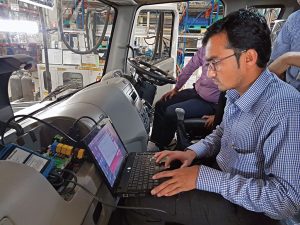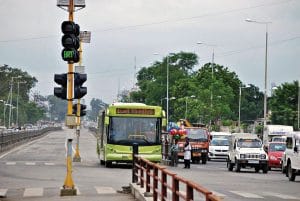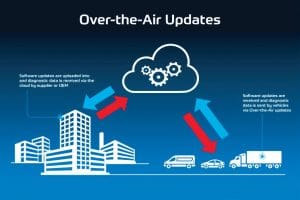 A new truck is about to roll out of the Mahindra & Mahindra’s Pune facility. Its ECU is being flashed at one of the last few stations on the final assembly line. Forming a core part of the truck’s functioning in real-world environment, the ECU or Electronic Control Module is highly electronic in nature. It is central to the functioning of the vehicle. Key to its mechatronic nature with an inline fuel injection a thing of the past, the ECU is the nerve centre of the common-rail engine powering this truck. The small aluminium cased box with heat sinks on it is at the heart of various electronic systems onboard the truck, including many other smaller such ECUs through a robust CAN-based communication network. Forming a backbone or facilitator of smooth and efficient working of the truck, the ECU is also a point of contact for seeking information about t
A new truck is about to roll out of the Mahindra & Mahindra’s Pune facility. Its ECU is being flashed at one of the last few stations on the final assembly line. Forming a core part of the truck’s functioning in real-world environment, the ECU or Electronic Control Module is highly electronic in nature. It is central to the functioning of the vehicle. Key to its mechatronic nature with an inline fuel injection a thing of the past, the ECU is the nerve centre of the common-rail engine powering this truck. The small aluminium cased box with heat sinks on it is at the heart of various electronic systems onboard the truck, including many other smaller such ECUs through a robust CAN-based communication network. Forming a backbone or facilitator of smooth and efficient working of the truck, the ECU is also a point of contact for seeking information about t
he truck from the outside! It is also a point of contact for transmitting information to the truck. Pointing at the passage of much data that would reveal information about the health of the vehicle, its location, the amount of fuel, speed, direction, driver behaviour, and much more, to its manufacturer as well as the operator, the new Mahindra truck, after it hits the road will be a ‘connected’ in nature.
 The ‘connected’ nature of this truck is quite common in the current environment. It is a key trend in automobiles. It is at the core of many new developments in vehicles – CVs as well as PVs. It is about obtaining raw data from the vehicle and vice versa in an effort to gather better understanding and insight of how things or machines work. About how they could be made to work better. It is thus the big data that is helping to acquire a valuable insight into the working of vehicles and the ecosystem that they thrive in. Helping to make vehicles safer, comfortable, reliable, efficient and cost effective, connectivity as a trend is turning out to be a big game-changer. It is facilitating the rise of big data with the use of electronic components to monitor as well as facilitate various functions on a commercial vehicle for example. Turning dealerships smarter and significantly reducing the time taken to develop a new vehicle, the connectivity trend is fueling renewed ability to store and process data at a much larger scale. To help build machine learning and artificial intelligence (AI) tools that become more effective and place and before have. Make have lower case and join the two sentences. Have greater scale. If a lane assist system would look untenable in India until recently, the accumulation of data and its analysis would by now have created an environment conducive for a specialist company to launch a system in association with a manufacturer.
The ‘connected’ nature of this truck is quite common in the current environment. It is a key trend in automobiles. It is at the core of many new developments in vehicles – CVs as well as PVs. It is about obtaining raw data from the vehicle and vice versa in an effort to gather better understanding and insight of how things or machines work. About how they could be made to work better. It is thus the big data that is helping to acquire a valuable insight into the working of vehicles and the ecosystem that they thrive in. Helping to make vehicles safer, comfortable, reliable, efficient and cost effective, connectivity as a trend is turning out to be a big game-changer. It is facilitating the rise of big data with the use of electronic components to monitor as well as facilitate various functions on a commercial vehicle for example. Turning dealerships smarter and significantly reducing the time taken to develop a new vehicle, the connectivity trend is fueling renewed ability to store and process data at a much larger scale. To help build machine learning and artificial intelligence (AI) tools that become more effective and place and before have. Make have lower case and join the two sentences. Have greater scale. If a lane assist system would look untenable in India until recently, the accumulation of data and its analysis would by now have created an environment conducive for a specialist company to launch a system in association with a manufacturer.
Big-data
 The once basic dots-on-a-map reporting having progressed much, big data s a key trend indeed that is supporting a plethora of developments. Greatly empowering near real-time business analytics as predictive and prescriptive software continues to advance. The promise of further innovation simply inevitable and significant, big data is enabling an ability to look beyond basic analytics such as miles driven versus cost paid, or the ability to track vehicle location — often with significant delays in data transmission. Helping quicker evolution through better analysis with larger data sets, big data is empowering commercial transportation-focused businesses of every size to dial higher efficiency and an ability to move more per tonne of cargo. Family-run companies with five or ten vehicles, and large corporate enterprises with 10,000 employees or more are better poised to access data and the information it would reveal. Any fleet-based company can utilize big data analytics, as mentioned above, to maximize revenue by focusing on core issues like driver safety, maintenance and fuel costs and vehicle utilisation.
The once basic dots-on-a-map reporting having progressed much, big data s a key trend indeed that is supporting a plethora of developments. Greatly empowering near real-time business analytics as predictive and prescriptive software continues to advance. The promise of further innovation simply inevitable and significant, big data is enabling an ability to look beyond basic analytics such as miles driven versus cost paid, or the ability to track vehicle location — often with significant delays in data transmission. Helping quicker evolution through better analysis with larger data sets, big data is empowering commercial transportation-focused businesses of every size to dial higher efficiency and an ability to move more per tonne of cargo. Family-run companies with five or ten vehicles, and large corporate enterprises with 10,000 employees or more are better poised to access data and the information it would reveal. Any fleet-based company can utilize big data analytics, as mentioned above, to maximize revenue by focusing on core issues like driver safety, maintenance and fuel costs and vehicle utilisation.
 While there are no simple answers to how big data is aiding to overcome challenges like rapidly rising fuel prices and that of consumables or the need to comply with rules and regulations, big data, it is evident, is proving useful to up efficiency and productivity. Tapping recent improvements in technology and methodology, it is enabling the ability to capture and process large quantities and varieties of data. The improvements in technology and methodology has made it simpler to adopt and implement new changes and processes. The big data obtained from an existing truck to ascertain how a new product could be made to weigh less, carry more payload, etc., is turning out to be an exciting proposition. Also, the ability to engineer products that attain better fuel efficiency through aerodynamic changes; through fuel metering and engine technology changes. Empowering people and organisations to look ahead of the time, big data is at the core of key trends visible in the CV industry.
While there are no simple answers to how big data is aiding to overcome challenges like rapidly rising fuel prices and that of consumables or the need to comply with rules and regulations, big data, it is evident, is proving useful to up efficiency and productivity. Tapping recent improvements in technology and methodology, it is enabling the ability to capture and process large quantities and varieties of data. The improvements in technology and methodology has made it simpler to adopt and implement new changes and processes. The big data obtained from an existing truck to ascertain how a new product could be made to weigh less, carry more payload, etc., is turning out to be an exciting proposition. Also, the ability to engineer products that attain better fuel efficiency through aerodynamic changes; through fuel metering and engine technology changes. Empowering people and organisations to look ahead of the time, big data is at the core of key trends visible in the CV industry. 
It is about a massive pile of information that brings with it the challenge of analyzing and categorizing it. It is also about turning it valuable and actionable; about making it descriptive, predictive and prescriptive. Interestingly, it is not just the OEMs that have been actively harnessing big data, there are firms that are working in the field of mass mobility which have been actively harnessing dig data as well.
ITS and OTA
 By actively harnessing big data, mass mobility firms have been gathering rare insights into developing tailored solutions, into attracting specific market segments, in enhancing service quality, and in delivering time and mission critical solutions. Bangalore’s BMTC for example has fitted each bus with a GPS unit. It has provided every conductor with a smart ticketing machine. As part of the ITS, it has bought itself the ability to solve issues of urban transport. The best part of this system is perhaps its ability to sync and pair data, transport data in terms of transmission as well as acquisition, over the air. It is a matter of time when ‘Over The Air’ (OTA) upgrades will be a common thing in CVs, mentions a technical expert. Automotive OEMs, he adds, are already OTA software upgrades (also termed as patches) since 2017 and 2018 in many parts of the world. The transition to BSVI has made it possible for OEMs in India too, he asserts. If the adoption of OTA has been slow, it is because automobiles, agricultural machinery, and industrial machinery are complex than smartphones and involve multiple moving parts controlled by ECUs. Vehicles have hundreds of microprocessors consisting of a few hundred million lines of code. OEMs are claimed to be developing OTA platforms in-house as well as in collaboration with OTA software and hardware solution specialists.
By actively harnessing big data, mass mobility firms have been gathering rare insights into developing tailored solutions, into attracting specific market segments, in enhancing service quality, and in delivering time and mission critical solutions. Bangalore’s BMTC for example has fitted each bus with a GPS unit. It has provided every conductor with a smart ticketing machine. As part of the ITS, it has bought itself the ability to solve issues of urban transport. The best part of this system is perhaps its ability to sync and pair data, transport data in terms of transmission as well as acquisition, over the air. It is a matter of time when ‘Over The Air’ (OTA) upgrades will be a common thing in CVs, mentions a technical expert. Automotive OEMs, he adds, are already OTA software upgrades (also termed as patches) since 2017 and 2018 in many parts of the world. The transition to BSVI has made it possible for OEMs in India too, he asserts. If the adoption of OTA has been slow, it is because automobiles, agricultural machinery, and industrial machinery are complex than smartphones and involve multiple moving parts controlled by ECUs. Vehicles have hundreds of microprocessors consisting of a few hundred million lines of code. OEMs are claimed to be developing OTA platforms in-house as well as in collaboration with OTA software and hardware solution specialists.
Proliferation of OTA platforms is also giving rise to the trend of automotive cyber security. Cyber security for commercial vehicles is of paramount importance. Mentions Gloria D’ Anna, the author of ‘SAE CyberSecurity for Commercial Vehicles’ that the CAN architecture of CVs lags behind PVs in their ‘open-ness’. She avers that the CAN architecture in a CV is dictated by the integration of aggregates that are sources from different suppliers. A hack into a truck’s CAN system can lead to a catastrophe, she quips. On a larger scale, it could cause the nation’s supply chain to collapse, she adds. As more and more CVs get connected, cyber security takes on a completely different level of relevance in terms of safety, security and productivity, mentions a technical expert working in the CV industry in Europe. It may not apply so much to India at this moment, he adds. The transition to higher emission levels and more automation will however require that any possibility of hacking is minimised, he informs further.
Automation
 Empowered by big data, and technological developments in the area of AI and IoT, automation to enhance safety, comfort and security is also one of the key trends taking root in CVs. In India, it is only starting to take off. It is however set to have much bigger appeal amid the challenge to keep costs down and improving road infrastructure. Automotive systems suppliers like ZF are at the forefront of this effort. While CV makers like Daimler have already launched their first road approved truck for autonomous operation in US, the ability to regulate it, standardise it, and the ability to ensure accountability are posing some limitations. Against such a background, the good part is, the truck driver is getting closer to realise his dream of being free of the steering wheel. This would help him or her to get to the role of a truck manager. Autonomous driving experiments are also being carried out in Europe. Experiments of reaching Level-Five autonomy are also underway in China. In India, the trend might take longer considering the market mind set, infrastructure and population. With huge potential in IT and analytical skills, a large portion of R&D and technological development in autonomy is being contributed for by the country. In fact, the experiments in the field of agricultural tractors regarding autonomy are expected to rub off the CVs sooner than later. A suitable legislative system and an open public opinion about such developments will need to be built.
Empowered by big data, and technological developments in the area of AI and IoT, automation to enhance safety, comfort and security is also one of the key trends taking root in CVs. In India, it is only starting to take off. It is however set to have much bigger appeal amid the challenge to keep costs down and improving road infrastructure. Automotive systems suppliers like ZF are at the forefront of this effort. While CV makers like Daimler have already launched their first road approved truck for autonomous operation in US, the ability to regulate it, standardise it, and the ability to ensure accountability are posing some limitations. Against such a background, the good part is, the truck driver is getting closer to realise his dream of being free of the steering wheel. This would help him or her to get to the role of a truck manager. Autonomous driving experiments are also being carried out in Europe. Experiments of reaching Level-Five autonomy are also underway in China. In India, the trend might take longer considering the market mind set, infrastructure and population. With huge potential in IT and analytical skills, a large portion of R&D and technological development in autonomy is being contributed for by the country. In fact, the experiments in the field of agricultural tractors regarding autonomy are expected to rub off the CVs sooner than later. A suitable legislative system and an open public opinion about such developments will need to be built.
An SAE paper released last year states that commercial vehicle manufacturers and suppliers, despite a pandemic that continues to punish global economic markets, have not relaxed efforts to bring high-level (SAE Level 4 or 5) autonomous trucks to market. The paper seeks attention to partnerships with self-driving tech startups as a big part of the roadmap, the latest example of which is the announcement by Navistar to co-develop SAE L4 trucks (targeted for production by 2024) with TuSimple. Stating that challenges pertain to the hard part of understanding how AI will deals with situations that happen uncommonly or are referred to as edge cases, an industry expert says, finding robust data sets of novel edge cases is something that will need a lot of investment and expertise. Rather than seeing exponential improvements in the quality of AI performance, the trend seems to follow exponential increases in the cost to improve AI systems, he adds. The realisation of an autonomous CV, it is clear, depends on on the usage environment, or Operational Design Domain (ODD). In controlled environments that can limit or eliminate unexpected obstacles and other unpredictable vehicles or scenarios, such as mining sites, ports and industrial areas, highly automated or even fully autonomous CVs already can be found. However, for long-haul trucking, where there’s perhaps the ‘biggest need and highest efficiency’ potential for autonomy, the operating environment is anything but predictable. The need is for a robust failure detection and the reaction strategy.



























